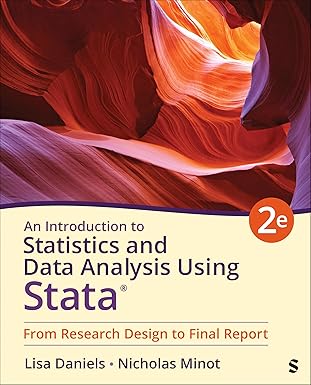By focusing on underlying themes, this book helps readers better understand the connections between multivariate methods. For each method the author highlights: the similarities and differences between the methods, when they are used and the questions they address, the key assumptions and equations, and how to interpret the results. The concepts take center stage while formulas are kept to a minimum. Examples using the same data set give readers continuity so they can more easily apply the concepts. Each method is also accompanied by a worked out example, SPSS and SAS input, and an example of how to write up the results. EQS code is used for the book’s SEM applications.
This extensively revised edition features:
- New SEM chapters including an introduction (ch.10), path analysis (ch.11), confirmatory factor analysis (ch.12), and latent variable modeling (ch.13) the last three with an EQS application.
- A new chapter on multilevel modeling (ch. 8) that is now used more frequently in the social sciences.
- More emphasis on significance tests, effect sizes, and confidence intervals to encourage readers to adopt a thorough approach to assessing the magnitude of their findings.
- A new data set that explores the work environment.
- More discussion about the basic assumptions and equations for each method for a more accessible approach.
- New examples that help clarify the distinctions between methods.
- A new website at https://sites.google.com/site/multivariatesecondedition/ that features the datasets for all of the examples in the book for use in both SPSS and SAS and in EQS for the SEM chapters.
The first two chapters review the core themes that run through most multivariate methods. The author shows how understanding multivariate methods is much more achievable when we notice the themes that underlie these statistical techniques. This multiple level approach also provides greater reliability and validity in our research. After providing insight into the core themes, the author illustrates them as they apply to the most popular multivariate methods used in the social, and behavioral sciences. First, two intermediate methods are explored – multiple regression and analysis of covariance. Next the multivariate grouping variable methods of multivariate analysis of variance, discriminant function analysis, and logistic regression are explored. Next the themes are applied to multivariate modeling methods including multilevel modeling, path analysis, confirmatory factor analysis, and latent variable models that include exploratory structural methods of principal component and factor analysis. The book concludes with a summary of the common themes and how they pertain to each method discussed in this book.
Intended for advanced undergraduate and/or graduate courses in multivariate statistics taught in psychology, education, human development, business, nursing, and other social and life sciences, researchers also appreciate this book‘s applied approach. Knowledge of basic statistics, research methods, basic algebra, and finite mathematics is recommended.
چکیده فارسی
این کتاب با تمرکز بر روی موضوعات اساسی، به خوانندگان کمک میکند تا ارتباطات بین روشهای چند متغیره را بهتر درک کنند. برای هر روش، نویسنده این موارد را برجسته میکند: شباهتها و تفاوتهای بین روشها، زمانی که از آنها استفاده میشود و سؤالاتی که به آنها میپردازند، مفروضات و معادلات کلیدی، و نحوه تفسیر نتایج. مفاهیم در مرکز توجه قرار می گیرند در حالی که فرمول ها به حداقل می رسد. مثالهایی که از مجموعه دادههای یکسانی استفاده میکنند به خوانندگان تداوم میدهند تا بتوانند راحتتر مفاهیم را به کار گیرند. هر روش همچنین با یک مثال کار شده، ورودی SPSS و SAS و نمونه ای از نحوه نوشتن نتایج همراه است. کد EQS برای برنامه های کاربردی SEM کتاب استفاده می شود.
این نسخه به طور گسترده اصلاح شده دارای ویژگی های:
است
- فصلهای SEM جدید شامل مقدمه (شاخه 10)، تجزیه و تحلیل مسیر (فصل 11)، تحلیل عامل تأییدی (فصل 12)، و مدلسازی متغیر پنهان (فصل 13) سه مورد آخر با یک برنامه EQS.< /li>
- فصل جدیدی در مورد مدلسازی چندسطحی (فصل 8) که اکنون بیشتر در علوم اجتماعی استفاده می شود.
- تاکید بیشتر بر آزمونهای اهمیت، اندازههای اثر، و فاصلههای اطمینان برای تشویق خوانندگان به اتخاذ رویکردی کامل برای ارزیابی بزرگی یافتههایشان.
- یک مجموعه داده جدید که محیط کار را بررسی می کند.
- بحث بیشتر در مورد فرضیات و معادلات اساسی برای هر روش برای یک رویکرد قابل دسترس تر.
- نمونه های جدیدی که به روشن شدن تمایز بین روش ها کمک می کند.
- یک وبسایت جدید به آدرس https://sites.google.com/site/multivariatesecondedition/ که مجموعه دادههای همه نمونههای کتاب را برای استفاده در SPSS و SAS و EQS ارائه میکند. برای فصل های SEM.
دو فصل اول، مضامین اصلی را که در اکثر روشهای چند متغیره اجرا میشوند، مرور میکنند. نویسنده نشان میدهد که چگونه درک روشهای چند متغیره زمانی که به مضامینی که زیربنای این تکنیکهای آماری هستند، دست یافتنیتر است. این رویکرد چند سطحی همچنین قابلیت اطمینان و اعتبار بیشتری را در تحقیقات ما فراهم می کند. نویسنده پس از ارائه بینشی به مضامین اصلی، آنها را همانطور که در محبوبترین روشهای چند متغیره مورد استفاده در علوم اجتماعی و رفتاری به کار میرود، نشان میدهد. ابتدا، دو روش میانی بررسی میشوند - رگرسیون چندگانه و تحلیل کوواریانس. در ادامه روشهای متغیر گروهبندی چند متغیره تحلیل واریانس چند متغیره، تحلیل تابع تفکیککننده و رگرسیون لجستیک بررسی میشوند. سپس مضامین به روشهای مدلسازی چند متغیره از جمله مدلسازی چندسطحی، تحلیل مسیر، تحلیل عاملی تأییدی و مدلهای متغیر پنهان که شامل روشهای ساختاری اکتشافی تحلیل عاملی و مؤلفههای اصلی است، اعمال میشوند. این کتاب با خلاصهای از موضوعات رایج و نحوه ارتباط آنها با هر روشی که در این کتاب مورد بحث قرار گرفته است، به پایان میرسد.
محققان همچنین از رویکرد کاربردی این کتاب قدردانی میکنند که برای دورههای پیشرفته کارشناسی و/یا کارشناسی ارشد در آمارهای چند متغیره در روانشناسی، آموزش، توسعه انسانی، تجارت، پرستاری و سایر علوم اجتماعی و زندگی تدریس میشود. آشنایی با آمار پایه، روش های تحقیق، جبر پایه و ریاضیات محدود توصیه می شود.
ادامه ...
بستن ...
ISBN-13: 978-0415873727
ISBN-10: 041587372X
ادامه ...
بستن ...










